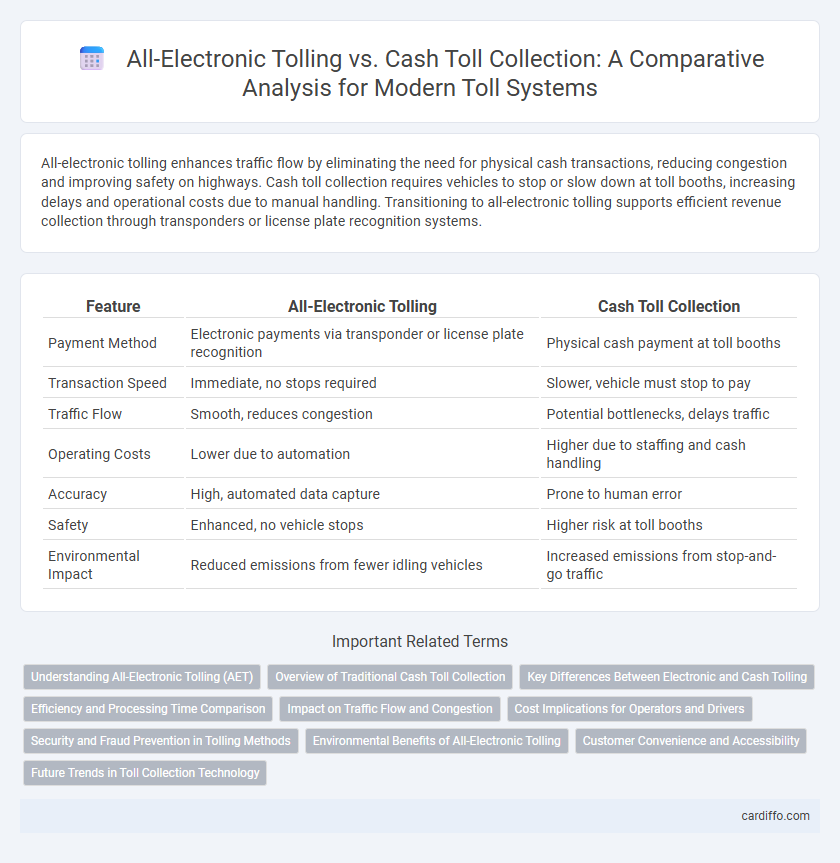All-electronic tolling enhances traffic flow by eliminating the need for physical cash transactions, reducing congestion and improving safety on highways. Cash toll collection requires vehicles to stop or slow down at toll booths, increasing delays and operational costs due to manual handling. Transitioning to all-electronic tolling supports efficient revenue collection through transponders or license plate recognition systems.
Table of Comparison
| Feature | All-Electronic Tolling | Cash Toll Collection |
|---|---|---|
| Payment Method | Electronic payments via transponder or license plate recognition | Physical cash payment at toll booths |
| Transaction Speed | Immediate, no stops required | Slower, vehicle must stop to pay |
| Traffic Flow | Smooth, reduces congestion | Potential bottlenecks, delays traffic |
| Operating Costs | Lower due to automation | Higher due to staffing and cash handling |
| Accuracy | High, automated data capture | Prone to human error |
| Safety | Enhanced, no vehicle stops | Higher risk at toll booths |
| Environmental Impact | Reduced emissions from fewer idling vehicles | Increased emissions from stop-and-go traffic |
Understanding All-Electronic Tolling (AET)
All-Electronic Tolling (AET) eliminates the need for cash transactions by using electronic sensors and transponders to automatically collect toll fees, improving traffic flow and reducing congestion. AET systems rely on technologies such as RFID, automatic license plate recognition (ALPR), and interoperable toll accounts to accurately charge vehicles without stopping. This method enhances safety, lowers operating costs, and provides real-time data for toll management authorities.
Overview of Traditional Cash Toll Collection
Traditional cash toll collection involves manual payment at toll booths where drivers stop to pay toll collectors or deposit coins into machines. This method requires physical infrastructure such as toll plazas and staffed booths, leading to traffic congestion and increased operational costs. Cash toll collection also poses challenges in accuracy, security, and efficient traffic flow compared to electronic systems.
Key Differences Between Electronic and Cash Tolling
All-electronic tolling uses electronic transponders or license plate recognition for seamless payment, eliminating the need for physical stops, while cash toll collection requires drivers to stop and pay in person, causing delays and requiring staffing. Electronic tolling improves traffic flow, reduces congestion, and lowers operational costs compared to cash tolling, which often results in longer queues and higher labor expenses. Additionally, all-electronic systems enhance accuracy and reduce toll evasion incidents by automating payment verification.
Efficiency and Processing Time Comparison
All-electronic tolling significantly reduces processing time by enabling vehicles to pass through toll points without stopping, improving traffic flow and decreasing congestion compared to cash toll collection, which requires drivers to stop or slow down for payment. Electronic systems use RFID tags or license plate recognition, allowing rapid, automated transactions that minimize human error and administrative costs. This technology enhances overall efficiency, lowering fuel consumption and emissions while providing accurate toll data in real-time.
Impact on Traffic Flow and Congestion
All-Electronic Tolling significantly reduces traffic congestion by eliminating the need for vehicles to stop or slow down at toll plazas, allowing continuous movement through toll points. In contrast, cash toll collection creates frequent bottlenecks as drivers pause to pay, leading to longer queues and increased traffic delays. Studies show highways with all-electronic tolling experience up to 40% improvement in traffic flow efficiency compared to traditional cash toll systems.
Cost Implications for Operators and Drivers
All-electronic tolling significantly reduces operational costs for toll authorities by eliminating the need for cash handling, toll booth maintenance, and labor expenses, translating into more efficient revenue collection. Drivers experience lower costs over time as electronic systems decrease traffic congestion and vehicle idling, leading to fuel savings and less wear and tear. The transition from cash toll collection to all-electronic systems promotes economic efficiency for operators while providing cost benefits and convenience for drivers.
Security and Fraud Prevention in Tolling Methods
All-electronic tolling enhances security by eliminating physical cash handling, reducing the risk of theft and fraud associated with cash toll collection. Advanced encryption and license plate recognition technologies in electronic tolling systems provide accurate vehicle identification, minimizing toll evasion and data tampering. Cash toll collection remains vulnerable to counterfeit currency, human error, and employee theft, making electronic systems a more secure and reliable option for toll operations.
Environmental Benefits of All-Electronic Tolling
All-electronic tolling (AET) significantly reduces vehicle emissions by eliminating the need for cars to stop or slow down at toll plazas, thereby decreasing idling time and fuel consumption. Studies show AET can lower greenhouse gas emissions by up to 30% compared to traditional cash toll collection. The reduction in exhaust pollutants contributes to improved air quality and supports broader environmental sustainability efforts in transportation infrastructure.
Customer Convenience and Accessibility
All-electronic tolling enhances customer convenience by eliminating the need for cash transactions, enabling seamless, fast highway travel without stopping at toll booths. This system increases accessibility by supporting various payment methods such as transponders and mobile apps, which cater to diverse customer preferences and reduce traffic congestion. Conversely, cash toll collection can cause delays and limit accessibility for drivers unfamiliar with exact change or unable to use electronic payment options.
Future Trends in Toll Collection Technology
All-electronic tolling (AET) is rapidly replacing cash toll collection due to its efficiency, reduced congestion, and enhanced revenue accuracy. Future trends in toll collection technology include increased integration of vehicle-to-infrastructure (V2I) communication, advanced license plate recognition (LPR) systems, and dynamic pricing models powered by artificial intelligence to optimize traffic flow. Emerging solutions focus on interoperability across regions and real-time data analytics to improve toll operations and user experience.
All-Electronic Tolling vs Cash Toll Collection Infographic

 cardiffo.com
cardiffo.com